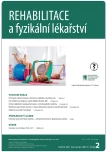Patients’ adherence to physiotherapy
Authors:
Prunerová A. 1; Nováková T. 1; Kupka K. 2; Reckziegelová P. 1
Authors‘ workplace:
Katedra fyzioterapie, Fakulta tělesné výchovy a sportu, Univerzita Karlova, Praha
1; TriloByte Statistical Software s. r. o., Pardubice
2
Published in:
Rehabil. fyz. Lék., 28, 2021, No. 2, pp. 89-95.
Category:
Original Papers
doi:
https://doi.org/10.48095/ccrhfl202189
Overview
Background: Physiotherapy includes many techniques which can be effective in the treatment of musculoskeletal system. It is up to each patient how he or she will approach their health. An evaluation of adherence to exercise can be beneficial at the beginning, during and after the end of physiotherapy. Objectives: The aim of this study was to use the Exercise Adherence Rating Scale (EARS) to find out how patients adhere to a physiotherapeutic treatment plan and assess the causes. Methods: The research group consisted of 151 respondents, all of them older than 18 years, who underwent physiotherapy at least once in their lives. The EARS was used for data collection. The Scale was available via an online research survey in March 2020 in a self-selection mode. Results: According to the results, 67% employees participated in the research study. 63% respondents were aged between 36 and 64 years. Most of them underwent physiotherapy covered by health insurance. In the EARS, excellent internal consistency values were shown in Section B items defining de adherence rate, while and satisfactory to good internal consistency values were obtained for Section C items determining obstacles to exercise. The significant correlation between the EARS sections confirms criterion validity in terms of adherence. The rate of adherence significantly varies by gender, education, employment and form of physiotherapy payment. Pleasant feelings after exercising did not necessarily increase with age. Retired people showed a lower degree of adherence, while economically active population had a rather higher degree of adherence. Higher level of education correlated with irregular exercise and its premature ending. The limits of the study include a low male participation in comparison to women 1 : 2.
Keywords:
adherence – treatment – barriers – Physiotherapy – Sports – Pain
Sources
1. Prunerová A. Adherence pacientů k fyzioterapii. Diplomová práce. Praha: Univerzita Karlova, Fakulta tělesné výchovy a sportu 2020.
2. Ištoňová M, Kociánová K, Homzová P et al. Všeobecná fyzioterapia. 1.vyd. Prešov: Fakulta zdravotnictva Prešovskej univerzity v Prešově 2008.
3. Lewit K. Manipulační léčba v myoskeletální medicíně. Praha: Sdělovací technika ve spolupráci s ČLS JEP 2003.
4. Newman-Beinart NA, Norton S, Dowling D et al. The development and initital psychometric evaluation of a measure assessing adherence to prescribed exercise: the Exercise Adherence Rating Scale (EARS). Physiotherapy 2017; 103(2): 180–185. doi: 10.1016/j.physio.2016.11.001.
5. Stone AA, Shiffman S, Schwartz JE et al. Patient compliance with paper and electronic diares. Control Clin Trials 2003; 24(2): 182–199. doi: 10.1016/s0197-2456(02)00320-3.
6. Sluijs EM, Kok GH, van der Zee J. Correlates of exercise compliance and physical therapy. Phys Ther 1993; 73(11): 771–786. doi: 10.1093/ptj/73.11.771.
7. Naqvi AA, Hassali MA, Naqvi SBS et al. Development and validation of the General Rehabilitation Adherence Scale (GRAS) in patients attending physical therapy clinics for musculoskeletal disorders. BMC Muskuloskeletal Disord 2020; 21(1): 1–11.
8. Forkan R, Pumper B, Smyth N et al. Exercise adherences following physical therapy interventions in older adults with impaired balance. Phys Ther 2006; 86(3): 401–410.
9. Martin LR, Williams SL, Haskard KB et al. The challenge of patient adherence. Ther Clin Risk Manag 2005; 1(3): 189–199.
10. Aitken D, Buchbinder R, Jones G et al. Interventions to improve adherence to exercise for chronic musculoskeletal pain in adults. Aust Fam Physician 2015; 44(1–2): 39–42.
11. Fekete EM, Stephens MAP, Druley JA et al. Effects of spousal control and support on older adult’s recovery from knee surgery. J Fam Psychol 2006; 20(2): 302–310. doi: 10.1037/0893-3200.20.2.302.
12. Schoo AMM, Morris ME, Bui QM. Predictors of home exercise adherence in older people with osteoarthritis. Physiother Can 2005; 57(3): 179–187. doi: 10.3138/ptc.57.3.179.
13. Sluijs EM, Knibbe JJ. Patient compliance with exercise: different theoretical approaches to short-term and long-term compliance. Patient Education and Counseling 1991; 191–204. doi: 10.1016/0738-3991(91)90060-I.
14. Grindley EJ, Zizzi SJ, Nasypany AM. Use of protection motivation theory, affect, and barriers to understand and predict adherence to outpatient rehabilitation. Phys Ther 2008; 88(12): 1529–1540. doi: 10.2522/ptj.20070076.
15. Jack K, McLean SM, Moffett K et al. Barriers to treatment adherence in physiotherapy outpatient clinics: a systematic review. Man Ther 2010; 15(3): 220–228. doi: 10.1016/j.math.2009.12.004.
16. Meichenbaum D, Turk DC. Facilitating treatment adherence. A practitioner’s guidebook. New York: Plenum Press 1987.
Labels
Physiotherapist, university degree Rehabilitation Sports medicineArticle was published in
Rehabilitation & Physical Medicine

2021 Issue 2
- Hope Awakens with Early Diagnosis of Parkinson's Disease Based on Skin Odor
- Deep stimulation of the globus pallidus improved clinical symptoms in a patient with refractory parkinsonism and genetic mutation
Most read in this issue
- The effect of manipulation therapy on cervicocranial syndrome
- Historical development of motor control theories – from hierarchical theory to dynamic system
- Influence of footbike riding on the locomotor system of younger school children
- Effectiveness of therapeutic interventions in the treatment of pain associated with trigger points
